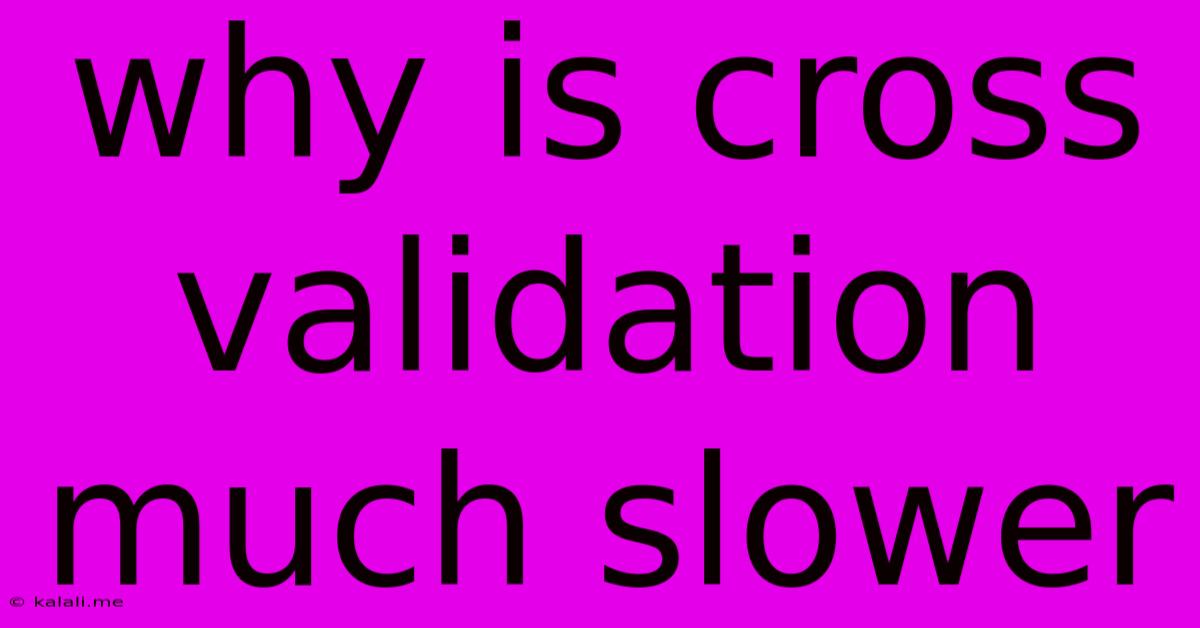Why Is Cross Validation Much Slower
Kalali
May 23, 2025 · 3 min read

Table of Contents
Why is Cross-Validation Much Slower Than a Single Train-Test Split?
Cross-validation, while a powerful technique for evaluating machine learning models and preventing overfitting, is undeniably slower than a single train-test split. This increased computational cost stems from the fundamental difference in how they approach model evaluation. This article delves into the reasons behind this performance discrepancy, exploring the inherent complexities and computational burdens involved in cross-validation.
Understanding the Core Difference:
A single train-test split divides your dataset into two parts: a training set used to fit the model and a test set used to evaluate its performance on unseen data. This is a straightforward, computationally inexpensive process.
Cross-validation, on the other hand, involves multiple train-test splits. The most common type, k-fold cross-validation, divides the data into k equal-sized folds. The model is trained k times, each time using a different fold as the test set and the remaining k-1 folds as the training set. This process generates k performance metrics, which are then averaged to obtain a more robust estimate of the model's generalization ability.
The Sources of Increased Computational Time:
The significant increase in computational time in cross-validation arises from these key factors:
-
Multiple Model Training: The most obvious contributor is the need to train the model multiple times (k times in k-fold cross-validation). Each training iteration involves the entire process of fitting the model to the training data, which can be computationally intensive, particularly for complex models and large datasets. This iterative training significantly increases the overall runtime.
-
Data Manipulation Overhead: Each iteration of cross-validation requires rearranging the data to create different training and testing sets. This data shuffling and partitioning process, although seemingly minor, adds up over multiple iterations, contributing to the overall computational cost, especially with large datasets.
-
Model Complexity: The complexity of the machine learning model itself plays a crucial role. More complex models, such as deep neural networks or complex ensemble methods, take longer to train. This increased training time is amplified in cross-validation due to the repeated training process.
-
Dataset Size: The size of the dataset directly impacts the computational cost. Larger datasets require more time for both data manipulation and model training. The effect is magnified in cross-validation because the training process is repeated multiple times.
Strategies for Mitigation:
While cross-validation is inherently more computationally expensive, several strategies can help mitigate the increased runtime:
-
Efficient Algorithms: Choosing computationally efficient machine learning algorithms can reduce the training time for each fold.
-
Parallel Processing: Modern computing environments support parallel processing. This allows you to train models on different folds concurrently, significantly reducing the overall runtime. Libraries like scikit-learn in Python offer parallel processing options for cross-validation.
-
Smaller k-Value: Using a smaller value for k (e.g., 3-fold or 5-fold) reduces the number of training iterations, thereby decreasing the computational cost. However, it's important to strike a balance between computational efficiency and the reliability of the performance estimate. A smaller k value may lead to higher variance in the performance estimate.
-
Data Subsampling: If computational resources are extremely limited, consider using a representative subsample of your dataset for cross-validation. This reduces the data size and hence the computational load, but may introduce some bias into the estimate. This approach should be used cautiously.
Conclusion:
Cross-validation's superior reliability in model evaluation comes at the cost of increased computational time compared to a single train-test split. Understanding the contributing factors—multiple model trainings, data manipulation, model complexity, and dataset size—allows for informed decisions about appropriate strategies to manage this computational cost. While the increase in time is unavoidable, careful consideration of these aspects can help optimize the process and make cross-validation a more manageable part of your machine learning workflow.
Latest Posts
Latest Posts
-
7am To 11am Is How Many Hours
Jul 12, 2025
-
If Your 35 What Year Was You Born
Jul 12, 2025
-
How Many Cups Is 1 Pound Of Cheese
Jul 12, 2025
-
30 X 30 Is How Many Square Feet
Jul 12, 2025
-
How Much Does A Half Oz Weigh
Jul 12, 2025
Related Post
Thank you for visiting our website which covers about Why Is Cross Validation Much Slower . We hope the information provided has been useful to you. Feel free to contact us if you have any questions or need further assistance. See you next time and don't miss to bookmark.